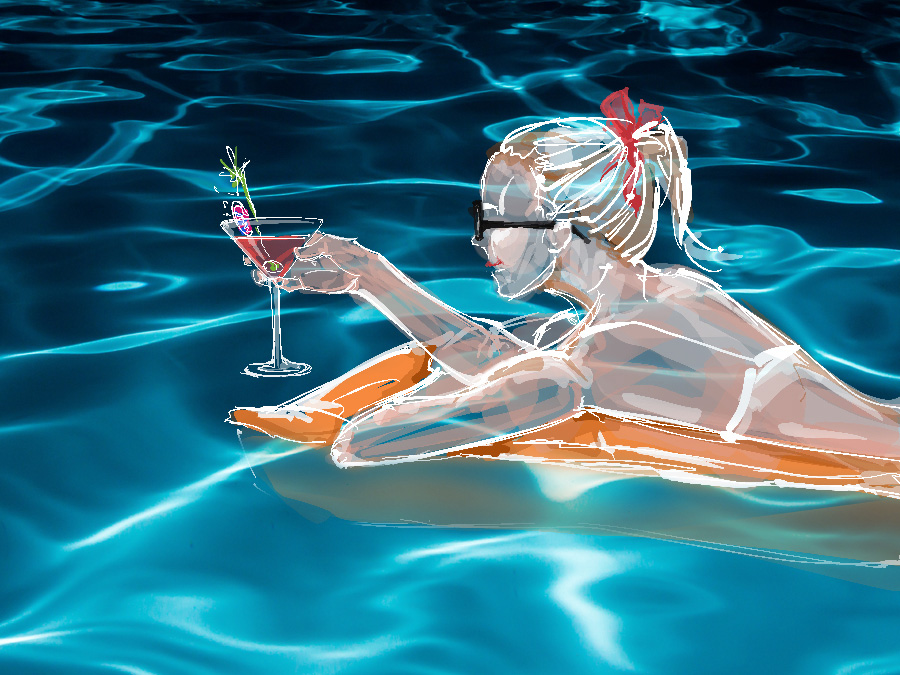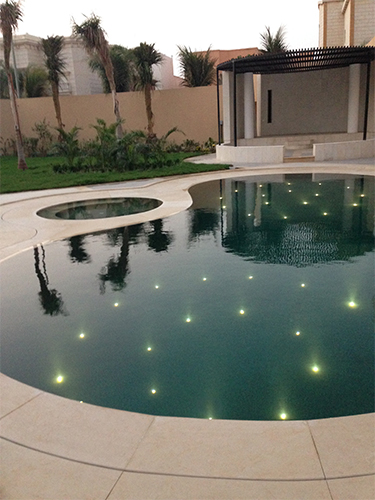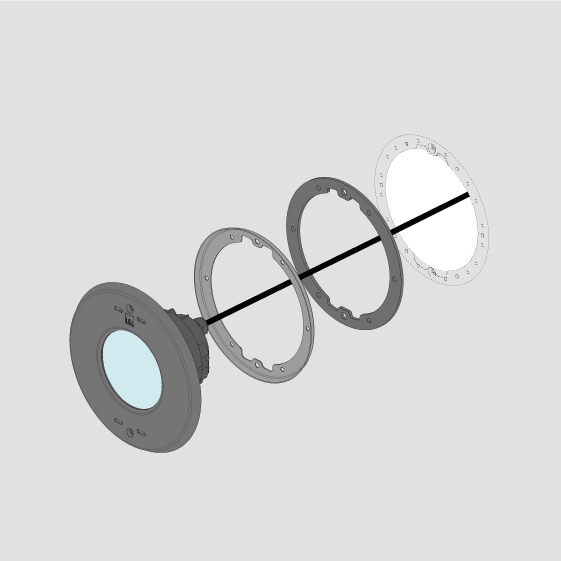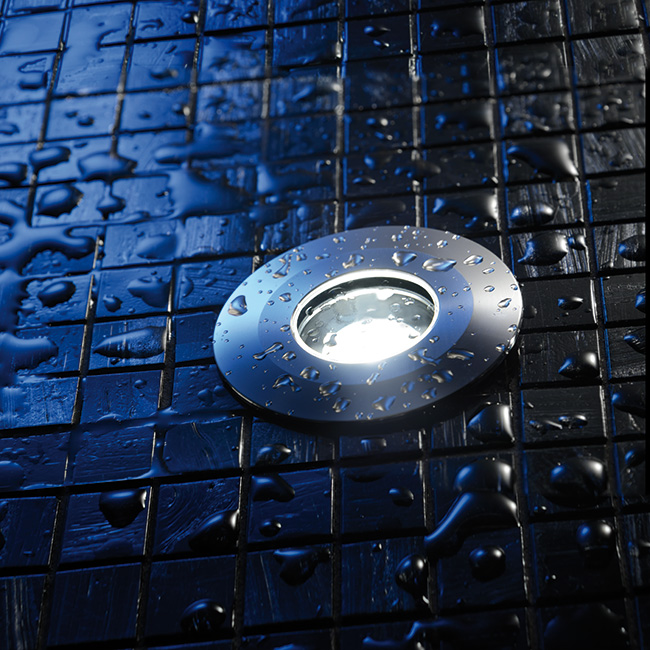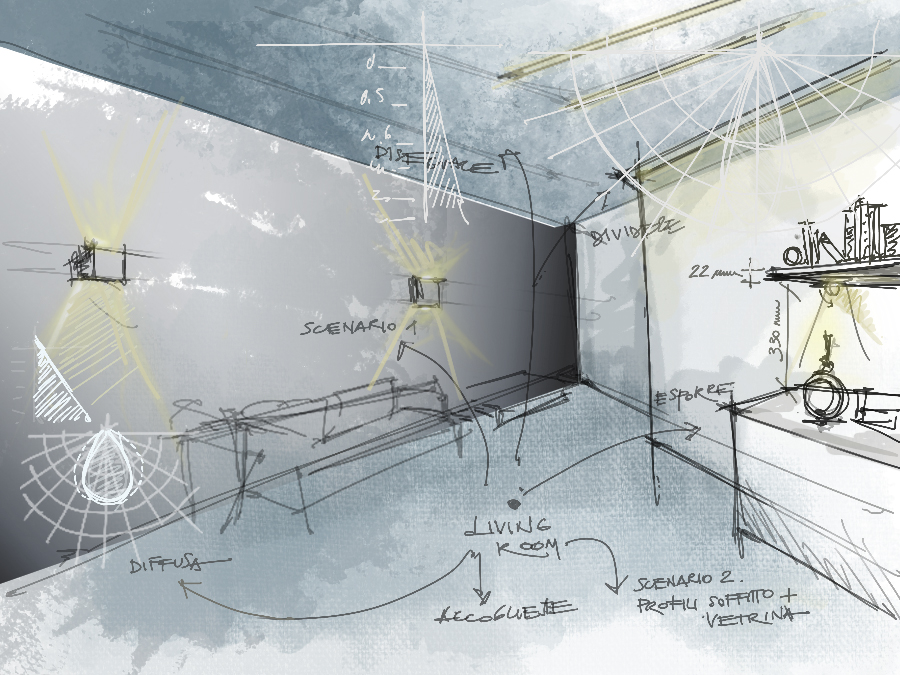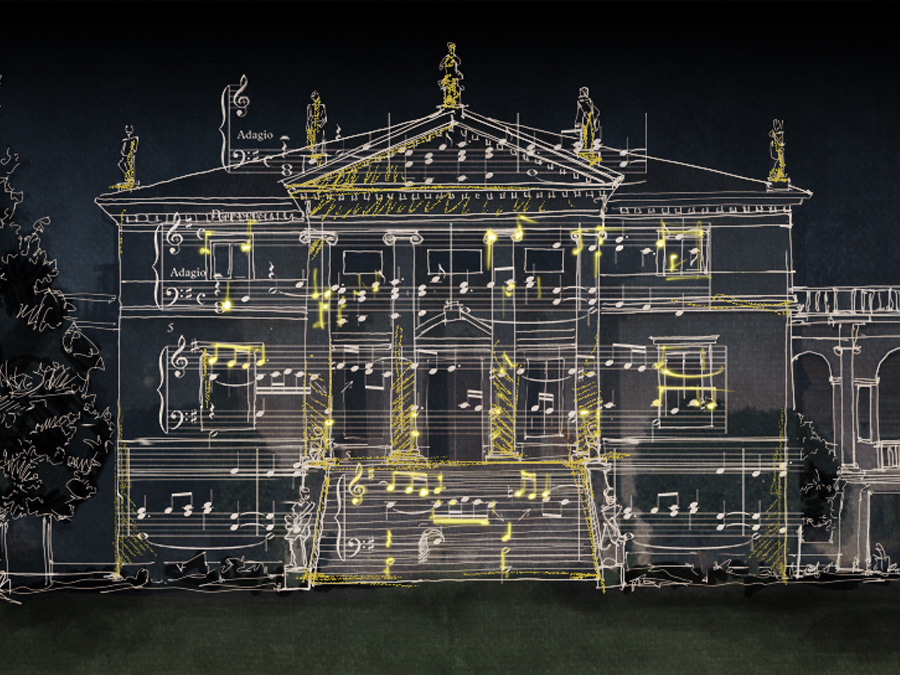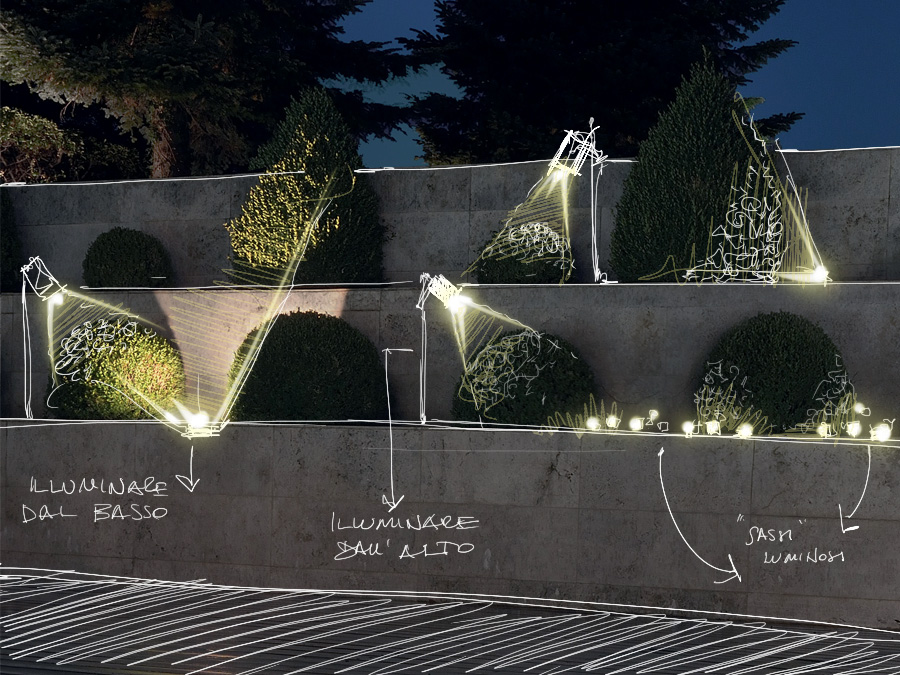| Author | L&L Communication Team |
|---|---|
| Category | Illuminating spaces |
| Read time: | min |
Underwater lighting is a deep, deep subject, so here we want to concentrate on the different kinds of swimming pools.
Some are the natural habitats of athletes, others are hangouts for cocktails and parties, and yet others are filled with thermal waters and are places for treatment and relaxation.
In the pool, light takes on different roles and forms depending on the activities taking place there. Colour and light output contribute to achieving the intended purpose, whether that be to create a mood, as it is for hotels, or functional, as when lighting the pool entrance area.
But let's take things one stroke at a time as we start our tour through this underwater world.
A dive into the past
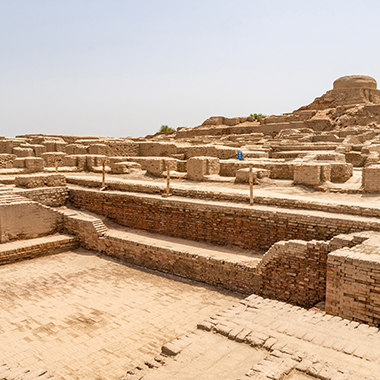
The history of swimming pools begins a long time ago.
We are in the 3rd millennium BCE in what is now Pakistan, in Mohenjo-daro, when the Great Bath was built, the first known large pool 1.
Centuries pass, and we are now in the Mediterranean Sea, where the ancient Greeks started the first swimming competitions, as part of the Isthmian Games 2. Swimming was important for the Romans, too, especially as a part of young people’s education and in military training. Alongside this, particularly in the imperial age, city baths flourished as places to meet and relax that were also open to plebeians. 3.
1, 2, 3: see bibliography below
Today, swimming is an Olympic sport, spa tourism is widespread, and it is not unusual to spend a summer afternoon with friends in a private pool.
Water sports
Hordes of children are lined up ready to learn their first strokes. Some are exchanging fearful glances with their classmates, some are laughing loudly and others are battling with the belt of a bathrobe that’s two sizes too big.
A few hours later, youths with statuesque physiques, professional goggles and an eye constantly on the stopwatch enter the pool.
In the evening, it’s the turn of the water lovers, who unwind by gliding up and down the lanes for an hour or so after a hard day's work.
From youngsters to office workers, the pool is used by people with different levels of ability but the same needs. In this kind of pool, given over to water sports, the lighting is at their service, allowing them to see clearly, both while swimming and when they are moving around the areas attached to the pool. The lighting inside the pool adds to the lighting outside it to achieve this aim, while also enhancing the water.
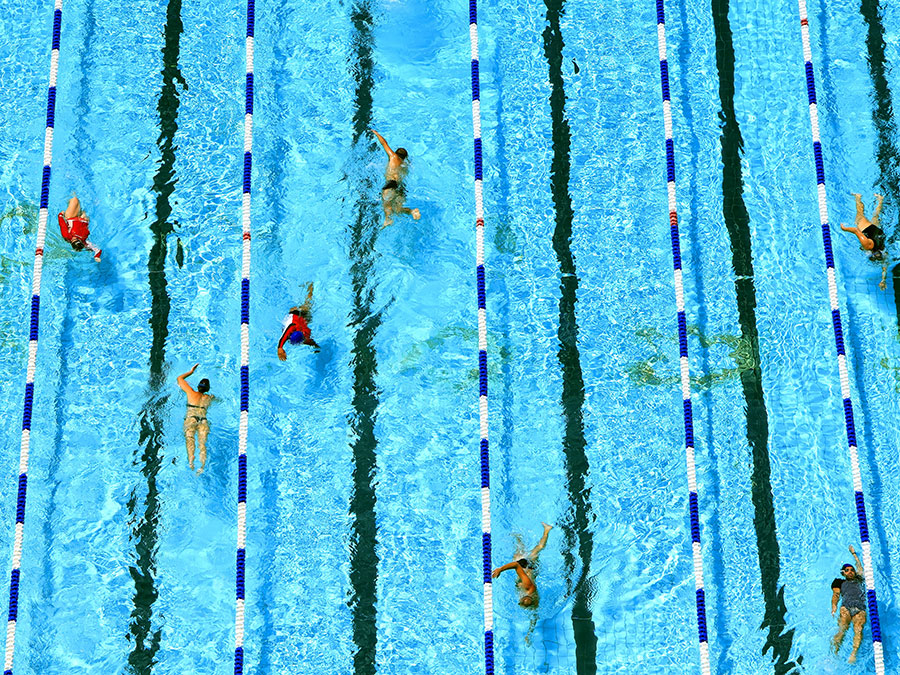
Three simple tips for lighting sports pools:
🔶 The most suitable optics in a pool are wide-beam optics to light the water volume uniformly.
🔶 The position of the light fittings: to allow users to swim without being disturbed (read dazzled) by the light, it is preferable to install the lighting fixtures along the long edge of the pool, to the side of the swimmer. If they were placed along the short edge, swimmers would risk being blinded by the light as they finished their lengths.
🔶 The height at which the fixtures are mounted usually varies between about 20 centimetres below the water surface and halfway up the pool side. Installing the fixtures just below the surface of the water means that the pool only needs to be emptied a little in the event of maintenance work, making life easier for facility managers and owners, especially if the pool is large.
The power of water
While sports pools run along more precisely defined design tracks, it is a different story in residential and hospitality contexts.
In this case, light no longer responds to a primarily functional need but, instead, plays an important part in creating the desired atmosphere for the locale and adding to its appeal. Pools enhance the perception of luxury in a location, and it is vital to play this card well, especially in the case of hospitality facilities.
Once the purely aesthetic infatuation has passed, a location wins us over when we feel that it can offer us positive experiences. We choose one hotel or holiday home over another when we feel that we can enjoy a more pleasant stay there.
A swimming pool acts as a calling card when we are scrolling through the various holiday options on the internet, and becomes a trump card when we have arrived at the property and are enjoying our experience.
The lighting can be instrumental in communicating a welcoming, relaxing feeling or in firing the imagination at the idea of an exclusive party.
What role does colour play in creating an atmosphere? What feelings does blue or green lighting inspire?
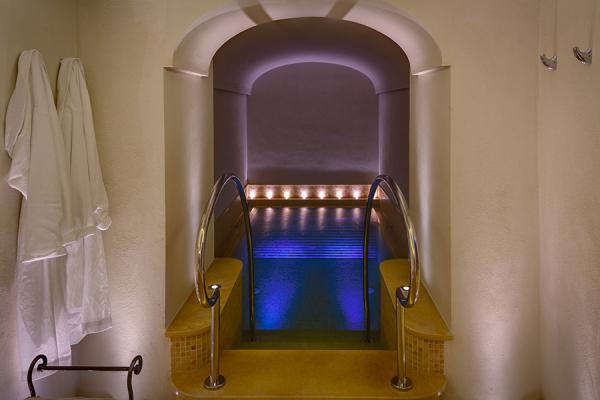
Bright 2.4, 3000K, 5W, 24° / Bright 2.0 316L, 4000K, 6W, 24° / Bright 1.0 316L, 3000K, 2W, 20° Go to the project and credits 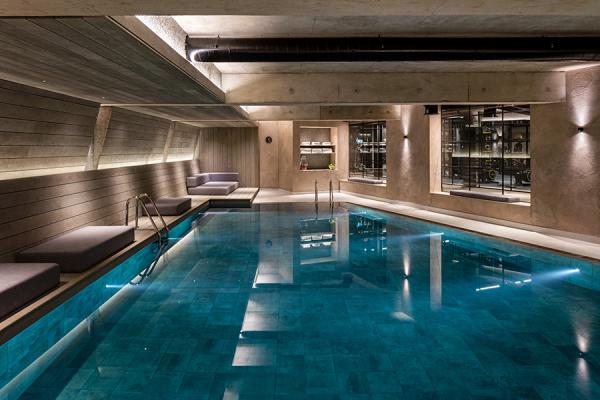
Bright 2.6 316L, 3000K, 6W, 24° Go to the project and credits
The colour of water
Blue and green tones transmit relaxation and harmony, thanks to their immediate associations with nature, the sky and the sea. In addition to calm and wellbeing, blue tones convey feelings of freshness and tranquillity, just like the waters of a Caribbean sea.
We usually see the walls of swimming pools clad in these shades, but they can also be achieved with light.
Below left, the light emitted by blue and green LEDs recreates the colours of the sea, from turquoise to azure. Just as in chromotherapy, here, too, colours can help to re-establish a balance in body and mind.
In it, the light generated by the LED sources is combined until the desired shade is achieved.
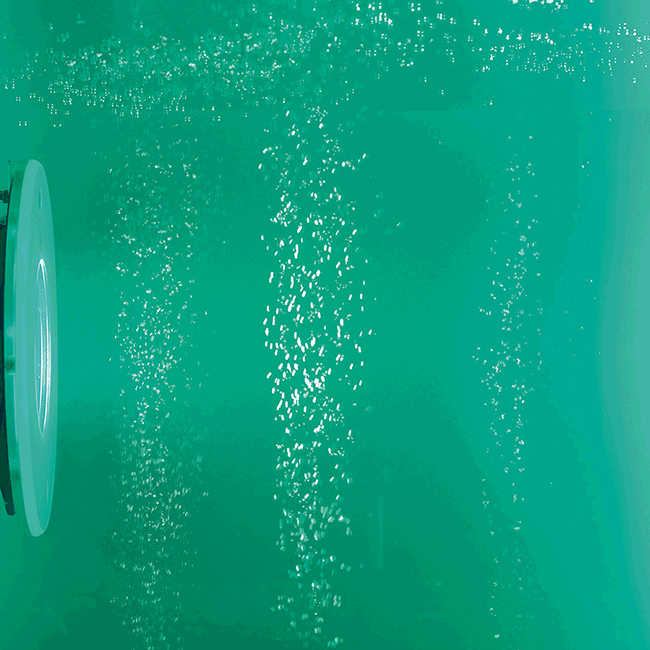
Shades of cyan Find out more about the product
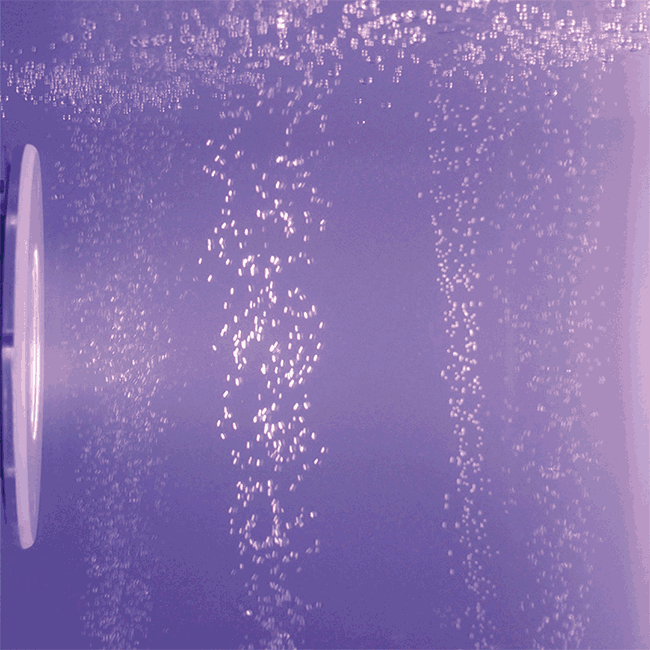
We could decide to colour the waters in a single shade or succumb to the attractions of colour-change lighting scenes to give the whole place a burst of energy and exuberance, for an early summer party, perhaps.
💡 📞 💡
Instead of playing with colours, would you rather light the water with a cool 6000K or dynamic white? Great idea, you just have to ask!
The texture of water
We've explored the role of light colour in painting a certain atmosphere. It’s now the turn of the lighting effect. Let's start with the different outputs from lighting fixtures.
You may choose to seek optical homogeneity and fill the pool with soft cones of light alternating with shadows, as in this example:
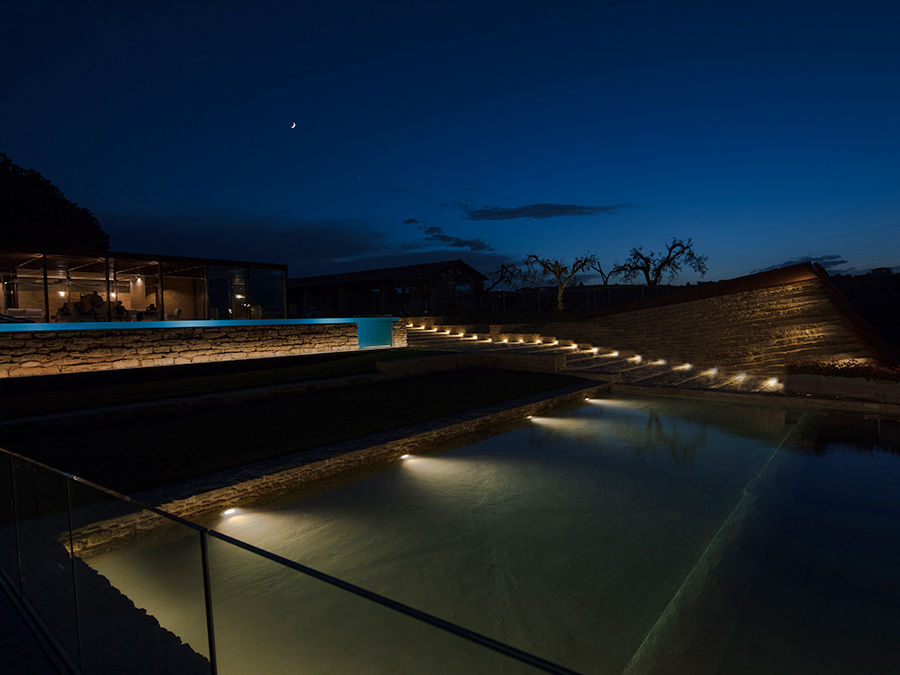
Moby 2.1, 3000K, 20W, 31°x64° Go to the project and credits
Otherwise, wide and narrow optics can be used together, as in the case of this villa on the Côte d'Azur, where wide optics were chosen for the shallow end of the pool, while narrower beams are at work in the deeper part.
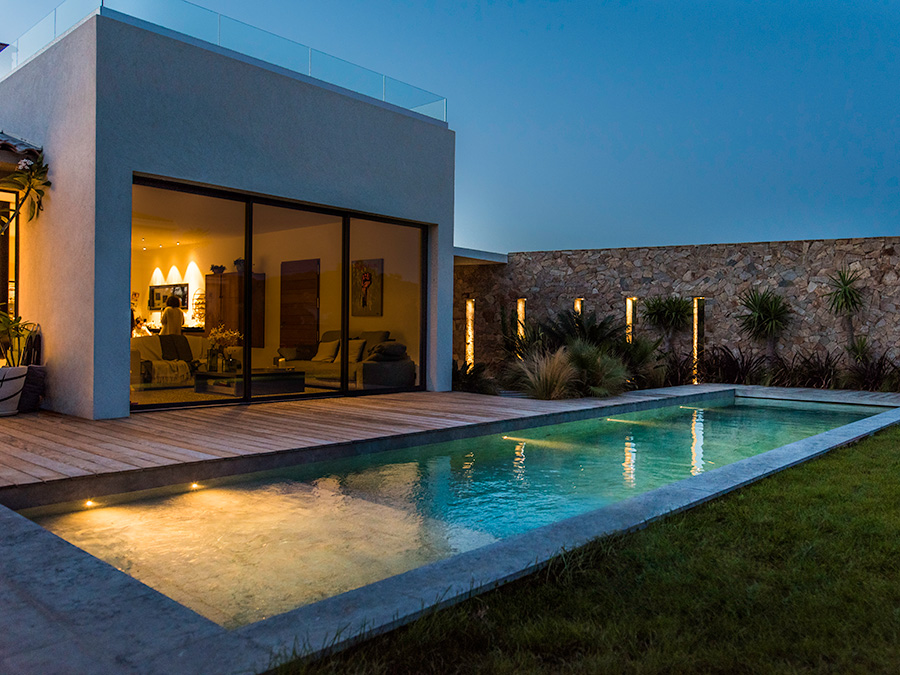
Bright 1.6 316L, 2700K, 2W, 40° / Bright 2.6 316L, 2700K, 6W, 24° Go to the project and credits
Another, more unusual option involves not simply aiming the lighting in a swimming pool at the water but also using it to provide indirect light.
Here, the fixtures are positioned at the bottom of the pool and reflect off the base of this “stilt house” to brighten the area around the pool.
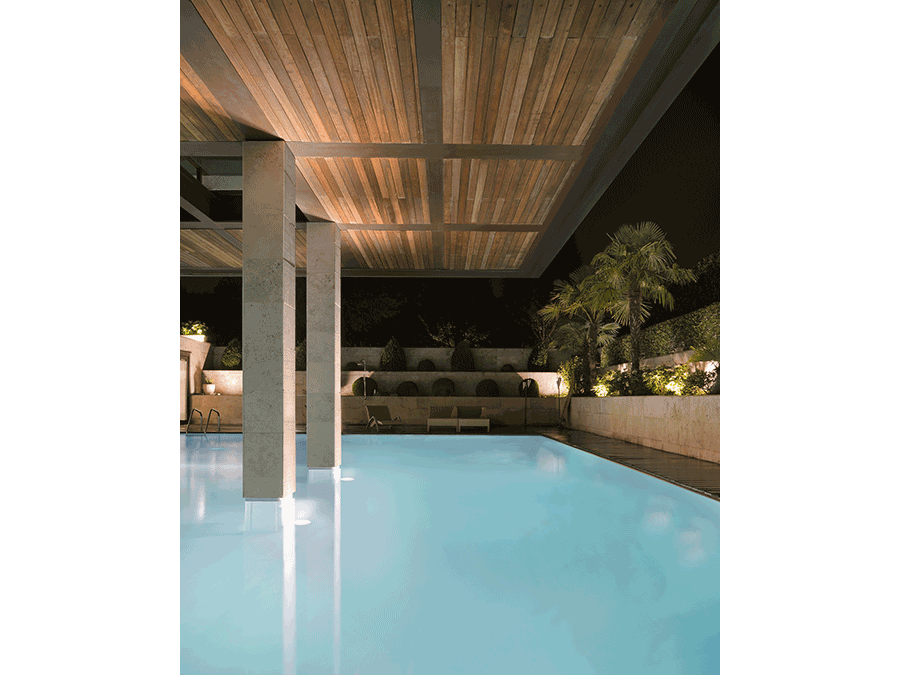
Moby 2.1, 3000K, 20W, 34° Find out more about the product
Vault of heaven
Lighting fixtures can also be installed on the floor of the pool to create a starry sky.
In the pool on the right, the architect Mohammad Mahmoud Azizi has dotted the bottom of the pool with recessed lighting fixtures with a diameter of only 35 mm, reminiscent of heaven’s vault.
Underwater constellations, this time in a pool with a classic rectangular shape, were also recreated by Ailon Gavish Studio Twilight, who did the light planning for this villa in Israel.
Whatever the pool shape, isn't there something poetical about immersing yourself in a starry sky?
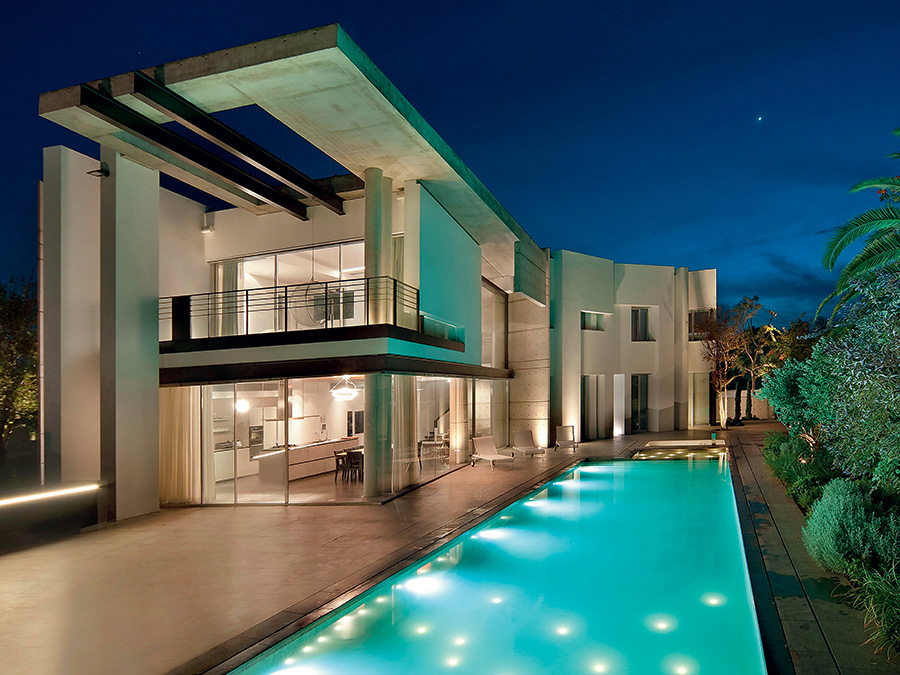
Bright 1.0 316L, 3000K, 2W, diffuse optics Go to the project and credits
Perimeter light
We mentioned earlier that lighting reinforces and enhances the perception of a locale.
This is certainly the case at the Rosewood Hotel in Bangkok, where their infinity pool, pictured below, features a linear profile with diffuse light along its edges. This profile, in a bespoke length, outlines the perimeter of the pool and creates a dividing line between water and air at the pool end.
The absence of edges or trims on the fixture’s cover gives more space to the line of diffuse light coming from the PMMA screen.
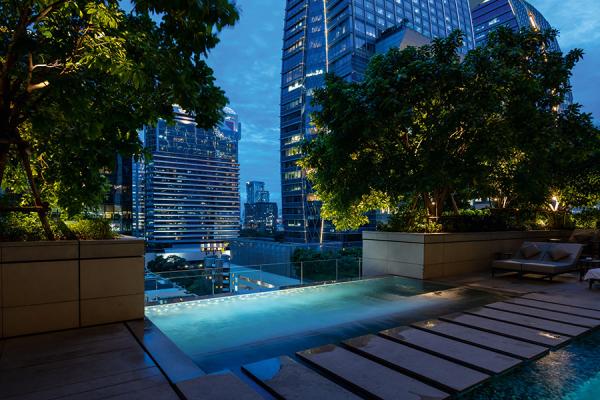
Rio Sub 2, 3700K, 19W/m, version with customized lengths and installation Go to the project and credits 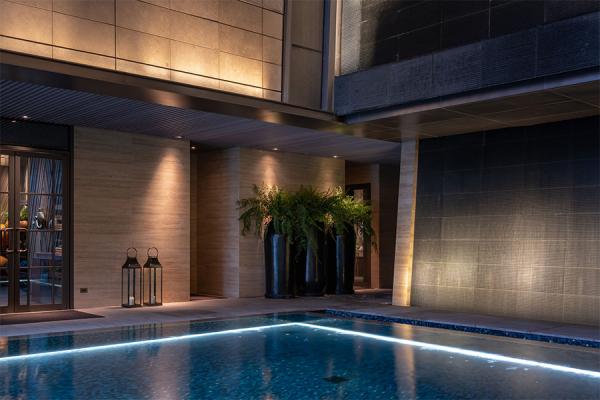
Rio Sub 2, 3700K, 19W/m, version with customized lengths and installation Go to the project and credits
One step at a time
So far, we’ve talked about light, both functional and emotional, used underwater. No less important, however, is the guidance role that lighting takes on, especially in outdoor pools.
Light accompanies us as we enter and leave the pool, illuminating the treads of the steps in, giving us the opportunity to enter the water slowly and acclimatise if we don’t feel like jumping straight in, or to exit safely, without fear of stumbling or having to scramble inelegantly out at the side.
For these applications, compact fixtures are the ideal solution, aesthetically discreet and at the same time able to light these areas appropriately.
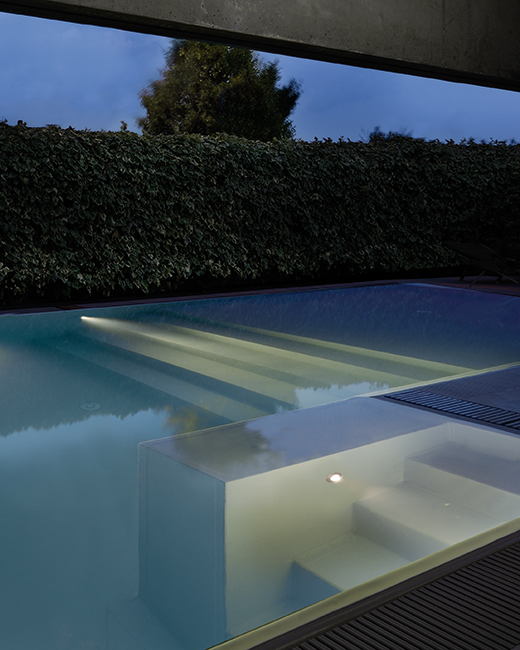
Bright 3.0 316L, 3000K, 9W, 45°-68° Find out more about the product
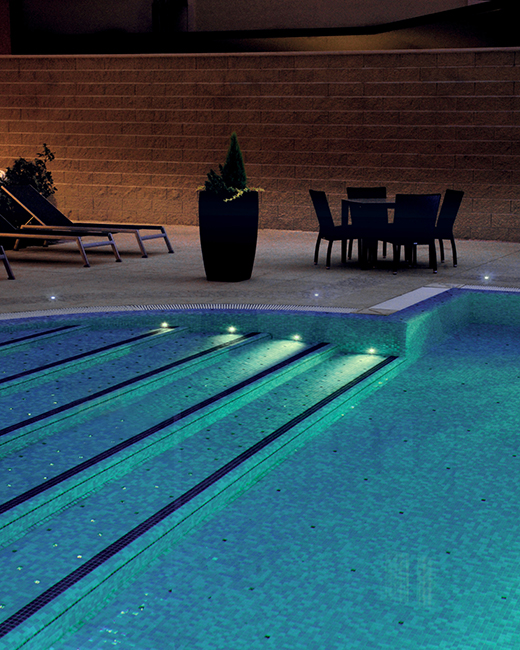
Bright 1.0 316L, 3000K, 2W, 20° Find out more about the product
Purpose-made kits and outer casings
The fixture chosen to light a pool determines the type of outer casing needed. It may need to be watertight or, on the other hand, it may need flood if the lighting fixture uses water to maintain the operating temperature in the correct range.
In the case of brick pools, no installation accessories are needed other than the outer casing.
However, for pools lined with a PVC liner, tiles or sheet metal, it is necessary to add purpose-made kits consisting of sealing rings and gaskets.
These kits protect the pool from water ingress between the wall cladding and the substructure.
The aggressiveness of water
Pools are a panacea for our minds and bodies, whether we are there to relax or have fun. They do not have the same effect on lamps, however. Over time, water can damage the fixtures, corroding them and impairing their function.
This is why we recommend paying great attention to the materials used.
🔶 Stainless steel, in particular AISI 316L, is the perfect material for underwater use, thanks to its corrosion-resistant properties.
🔶 In addition to stainless steel, thermally conductive technopolymers are well suited to use in lighting fixtures for swimming pools because of their ability to tolerate various corrosive agents in the water. They resist not only substances such as chlorine but also the sulphur present in thermal pools.
When the thermally conductive technopolymers are combined with an all-glass cover, the luminaires also become suitable for installation in salt water, which means not only sea water but also swimming pools where sterilisation is carried out using salt instead of chlorine. Not only that but their glass cover with vitrified serigraphy is also aesthetically pleasing, blending in with the pool walls.
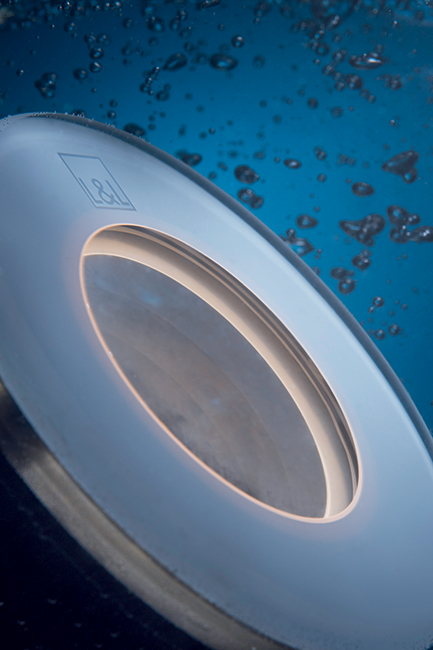
Moby P 1.1, 3000K, 9W, 34° Find out more about the product
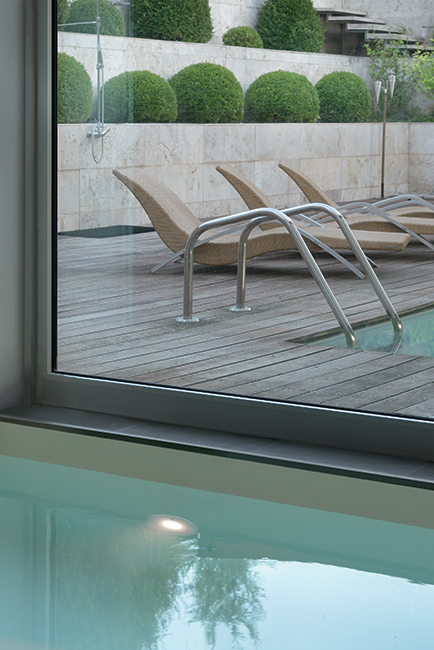
Moby 1.1, 3000K, 9W, 62° Find out more about the product
Similarly, PMMA linear profiles blend into the structure to the point where they disappear.
🔶 Poly(methyl methacrylate), to give PMMA its full name, is a thermoplastic polymer, and one of its qualities is resistance, which makes it especially suitable for underwater applications.
In the photograph below, recessed fixtures with a glass cover and PMMA profiles blend perfectly into the walls, leaving only the light to take centre stage in the water.
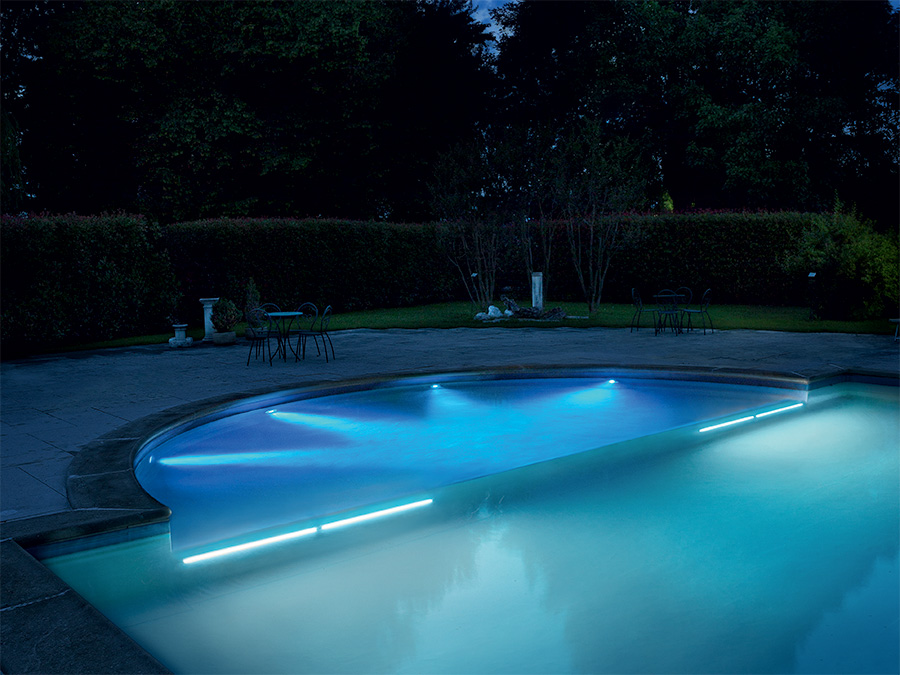
Rio Sub 2.2, 2800K, 19W / Moby 1.1, RGBW, 9W, 62°
Stay safe, stay low voltage
The material used is not the only aspect that defines a fixture’s suitability for permanent immersion. Let’s turn our attention to the power supply. For safety reasons, pool lighting fixtures must be low voltage, and the power supplies must be located away from the water.
That’s why we have 5-metre cables as standard for underwater fixtures, with the option of up to 20 metres.
Our fixtures are equipped with protection systems such as IPS, the acronym for Intelligent Protection System, an innovation patented by L&L that protects the fixtures from water ingress, which can occur if cables are spliced incorrectly.
💡 📞💡
Does your cable need to be in a length you can't find among those listed?
Or perhaps you need to replace some lamps, and the new fixtures need to have trims with very precise dimensions? Write to us: we can meet your requests!
Make your dream a reality
By now, you probably have a clear picture of your own pool. You know that you can choose between white light, RGB, RGBW or shades of cyan, and between creative or functional lighting effects, or guidance lighting. We have also addressed the importance of using the right materials to make a fixture reliable.
Now it’s your turn.
Do you need to light a swimming pool?
Bibliography
1 Harappa, https://www.harappa.com/about-us , 09/09/2020
2 Swim4lifemagazine, Nuoto, origini e nascita delle prime competizioni e dei primi stili, https://www.swim4lifemagazine.it/2020/05/29/nuoto-origini-nascita-prime-competizioni-stili/, 09/09/2020
3 Wikipedia, swimming pools, it.wikipedia.org/wiki/Piscina, 09/09/2020
Wikipedia, Roman baths, it.wikipedia.org/wiki/Terme_romane, 11/09/2020
Wikipedia, Ancient Roman bathing, en.wikipedia.org/wiki/Ancient_Roman_bathing, 11/09/2020

